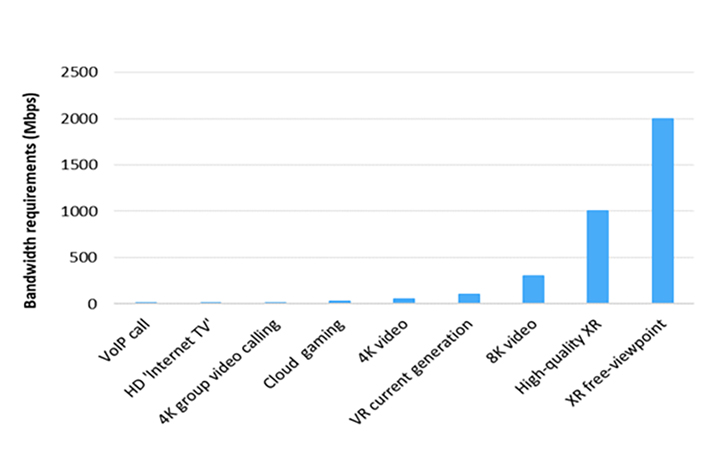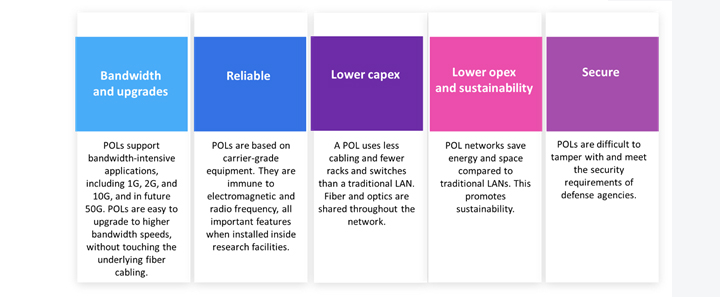This site uses cookies. By continuing to browse the site you are agreeing to our use of cookies. Read our privacy policy>
![]()
This site uses cookies. By continuing to browse the site you are agreeing to our use of cookies. Read our privacy policy>
![]()
Produits, solutions et services pour les entreprises
Universities are facing multiple challenges and COVID-19 has only exacerbated them. Students are seeking cutting-edge educational programs that will improve their performance outcomes while at university, and then in the workforce. Universities are striving to adopt new educational approaches but lack the underlying infrastructure to support seamless collaborative education between students and professors, regardless of their respective physical locations. In parallel, many universities are under pressure to reduce campus-related operational costs, such as electricity consumption and labor. The adoption of optical networking and, specifically, Passive Optical LAN (POL) is a key enabler for universities, providing a reliable, secure, and sustainable communications network, meeting the strict performance parameters required by new educational programs. In addition, POLs provide meaningful cost advantages over traditional Local Area Networks (LANs), including ease of upgrades, longevity, and less power and real-estate use.
While universities are leaders in implementing advanced smart building infrastructure, they are not leaders in adopting optical networking to support high-bandwidth applications throughout their campuses. The quick fixes implemented by university Information technology (IT) departments during COVID-19 are not sufficiently robust for Augmented Reality (AR) and Virtual Reality (VR) applications and collaborative, cloud-based educational programs. Many students suffered during lockdowns, trying to learn through tedious online lectures without the benefit of immersive or interactive learning experiences. Various studies have highlighted that online coursework generally yields worse performance than in-person coursework.
The underlying communications networks at universities must be modernized, taking advantage of new communications technologies, while supporting students, professors, and support staff, on campus and remotely. For example, universities are adding AR and VR to support educational instruction and real-life simulations, but older, copper-based networks cannot support the required bandwidth and low-latency requirements. In addition, many educators are focused on the metaverse, a virtual world facilitated by use of high-quality video, mixed with AR and VR. This metaverse supports collaborative work, whether between students on the same campus, or between on-campus and remote students, or across universities located in different countries. This educational approach can lead to truly international collaboration on classroom projects. It can train today’s students to take advantage of different knowledge bases and ways of thinking to solve international problems, such as climate change, sustainable, energy, or pandemics.
However, new immersive education techniques require both bandwidth and low-latency. Figure 1 provides an overview of bandwidth requirements for different types of applications. An Extended Reality (XR)-free viewpoint requires 2000 Mbit/s or 2G and this level of bandwidth requires optical networking. POL can support this bandwidth throughout a campus environment.

Figure 1: Demands on the network of future applications will exponentially grow
Source: Omdia
POL is a type of LAN that uses fiber-based equipment for campus-type settings. POLs have been deployed in campus settings throughout the world, offering reliable and secure broadband communications. POL uses passive optical cabling, single-mode fiber, and passive (non-powered) splitters. A POL consists of an Optical Line Terminal (OLT), which can be based in a university’s communications room, and Optical Network Units (ONUs), which can be placed throughout a campus, in labs, classrooms, auditoriums, offices, dormitory rooms, sports arenas, and cafeterias, for example. Each ONU supports multiple services and functions including voice, data, and video.
A POL offers numerous advantages compared to copper-based Ethernet LANs. The key strengths are summarized in Figure 2. POL advantages range from cost and upgradeability to security and sustainability.

Figure 2: POL’s key advantages
Source: Omdia
The University of Canada in Egypt (UCE) is located in New Cairo, the new administrative capital of Egypt, located 60 kilometers east of Cairo. UCE is an accredited university and offers students the opportunity to transfer and complete or further education in Canada. UCE installed POL for data, video, and voice connectivity throughout its campus. Now, POL is supporting collaborative research and education with the main campus in Canada and with its other remote campuses around the world. The POL is connecting labs, classrooms, stadiums, auditoriums, offices, dormitories, and cafeterias. UCE's POL deployment is providing high-speed broadband communications, along with edge computing, and cloud-based applications.
China Southwest University (CSU) installed its POL in 2012 to reduce network complexity and support cloud-based digital education. The university was facing network operational challenges, managing multiple networks for different services for different users. Its POL covers the entire campus, including classrooms, labs, offices, student centers, and dormitories. Since 2012, CSU has expanded and upgraded its POL, supporting growing bandwidth demand and cloud-based educational applications, for its 60,000 students, professors, administrators, and support staff. CSU continues to benefit from POL’s operational and management advantages, compared to traditional LANs.
In America, Washington State University (WSU) chose a POL to meet the broadband connectivity expectations of its students, while reducing capital investment and ongoing operating costs. The estimated cost of a traditional switched Ethernet infrastructure solution was nearly US$4700 per bed for a new residence hall compared to US$2900 for a POL. The university chose a POL as an affordable alternative, requiring less space, lower power consumption, and less time to implement than traditional copper-based solutions. The significant space savings made have enabled WSU to provide additional living areas for its students.
POLs are being adopted by universities around the world, enabling secure, highly-reliable broadband communications across campus, while supporting research collaboration and remote learning. Today's university students expect their educational experiences to include AR and VR along with seamless connectivity to cloud-based educational applications. A POL provide a campus with an easy-to-upgrade, high-capacity fiber communications network, connecting classrooms, labs, administrative and security offices, dorms, and auditoriums. In addition, POLs are less expensive to operate and manage than traditional LANs, a key factor as universities face rising costs.
Disclaimer: The views and opinions expressed in this article are those of the author and do not necessarily reflect the official policy, position, products, and technologies of Huawei Technologies Co., Ltd. If you need to learn more about the products and technologies of Huawei Technologies Co., Ltd., please visit our website at e.huawei.com or contact us.